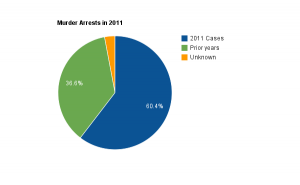The Washington Post advances a story first reported by Homicide Watch DC in December: The 94 percent case closure rate frequently cited by Police Chief Cathy Lanier, Mayor Vincent Gray and others hides more complicated arithmetic.
The closure rate she presents for the District is 154 percent higher than Boston’s and at least 104 percent higher than Baltimore’s, and it gives residents reason to believe that D.C. police have been remarkably successful at solving homicide cases under her watch.
But an examination of District homicides found that the department’s closure rate is a statistical mishmash that makes things seem much better than they are. The District had 108 homicides last year, police records show. A 94 percent closure rate would mean that detectives solved 102 of them. But only 62 were solved as of year’s end, for a true closure rate of 57 percent, according to records reviewed by The Post.
 Homicide Watch DC found similar numbers in December, using our own database. Cases closed with an arrest in 2011, regardless of when the actual murder occurred, are counted in 2011’s closure rate. Divide that number of closures by the number of homicides that occurred in 2011, and you get 94 percent. This method, Lanier told both Homicide Watch DC and the Post, is in line with the FBI’s Uniform Crime Report.
Homicide Watch DC found similar numbers in December, using our own database. Cases closed with an arrest in 2011, regardless of when the actual murder occurred, are counted in 2011’s closure rate. Divide that number of closures by the number of homicides that occurred in 2011, and you get 94 percent. This method, Lanier told both Homicide Watch DC and the Post, is in line with the FBI’s Uniform Crime Report.
When the Post contacted other cities to compare numbers, it found many kept two sets of closure rates: One following the FBI’s method, where any case closed adds to that year’s rate; and another counting only arrests made for murders happening the same year.
Geoffrey P. Alpert, a professor of criminology at the University of South Carolina in Columbia, said there are no national standards or rules governing how to count closed cases, a situation that prevents criminologists from using such data for more sophisticated analyses.
The numbers are “more administrative than scientific,” Alpert said. “Across the United States, there’s no real best practices or criteria for measuring closed cases.”
Read the full story here.






